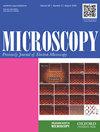小鼠多纤毛上皮纤毛发生异常模式的超微结构证据
IF 1.8
4区 工程技术
引用次数: 2
摘要
多纤毛发生是在单个细胞中产生数百个活动纤毛的级联过程。在脊椎动物中,这种过程已经在脑室的室管膜以及气道和输卵管的纤毛上皮中进行了研究。尽管扩增中心粒的早期步骤已经在分子细节上得到了表征,但随后建立多纤毛的步骤相对被忽视了。在这里,我们重点研究了先前在野生型小鼠室管膜中使用透射电子显微镜观察到的异常纤毛相关结构,并分析了它们的超微结构特征和发生频率。在室管膜中,$\ sim$5%的纤毛以束状存在;虽然大多数纤毛束是成对的,但也发现了三个以上纤毛束。此外,偶尔观察到含有多组轴突的顶端突起(每个切片0-2个),这表明纤毛形成的模式不同寻常。在气管和输卵管上皮中,纤毛束不存在,但观察到含有多个轴突的突起。在这种突起的底部,某些轴突完全被膜包裹,而另一些则保持不完全包裹。这些数据表明,多细胞纤毛发生的后期可能包括纤毛发育的独特过程,这与初级纤毛的纤毛发生不同。本文章由计算机程序翻译,如有差异,请以英文原文为准。
Ultrastructural evidence for an unusual mode of ciliogenesis in mouse multiciliated epithelia
Multiciliogenesis is a cascading process for generating hundreds of motile cilia in single cells. In vertebrates, this process has been investigated in the ependyma of brain ventricles and the ciliated epithelia of the airway and oviduct. Although the early steps to amplify centrioles have been characterized in molecular detail, subsequent steps to establish multicilia have been relatively overlooked. Here, we focused on unusual cilia-related structures previously observed in wild-type mouse ependyma using transmission electron microscopy and analyzed their ultrastructural features and the frequency of their occurrence. In the ependyma,
$\sim$
5% of cilia existed as bundles; while the majority of the bundles were paired, bundles of more than three cilia were also found. Furthermore, apical protrusions harboring multiple sets of axonemes were occasionally observed (0–2 per section), suggesting an unusual mode of ciliogenesis. In trachea and oviduct epithelia, ciliary bundles were absent, but protrusions containing multiple axonemes were observed. At the base of such protrusions, certain axonemes were completely enwrapped by membranes, whereas others remained incompletely enwrapped. These data suggested that the late steps of multiciliogenesis might include a unique process underlying the development of cilia, which is distinct from the ciliogenesis of primary cilia.
求助全文
通过发布文献求助,成功后即可免费获取论文全文。
去求助
来源期刊

Microscopy
工程技术-显微镜技术
自引率
11.10%
发文量
0
审稿时长
>12 weeks
期刊介绍:
Microscopy, previously Journal of Electron Microscopy, promotes research combined with any type of microscopy techniques, applied in life and material sciences. Microscopy is the official journal of the Japanese Society of Microscopy.
 求助内容:
求助内容: 应助结果提醒方式:
应助结果提醒方式:


